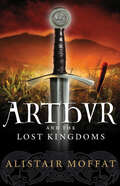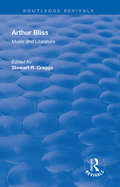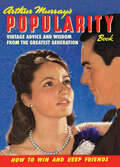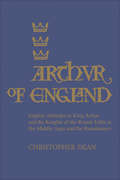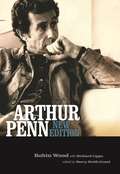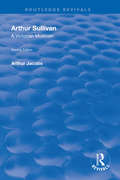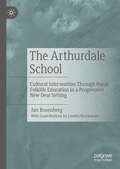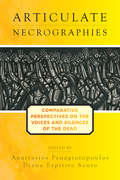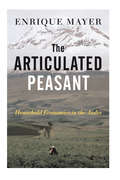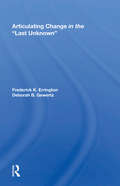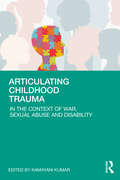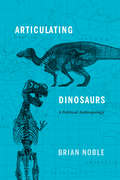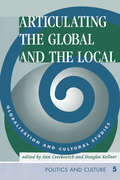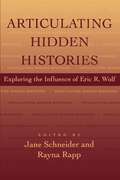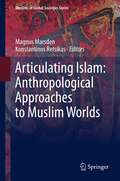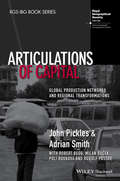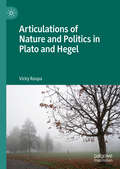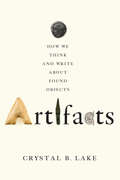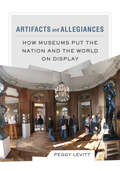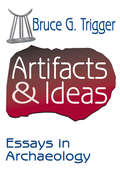- Table View
- List View
Arthik Sarvekshan Ani Kendriya Arthasankalpa Second Semester FYBA New NEP Syllabus - RTMNU: आर्थिक सर्वेक्षण आणि केंद्रीय अर्थसंकल्प दुसरे सत्र एफ.वाय.बी.ए. नवीन एन.इ.पी. अभ्यासक्रम - राष्ट्रसंत तुकडोजी महाराज नागपूर विद्यापीठ
by Prof. Dr. Rakshit Madan Bagdeराष्ट्रसंत तुकडोजी महाराज नागपूर विद्यापीठाच्या (RTMNU) नवीन राष्ट्रीय शैक्षणिक धोरण (NEP) 2020 अंतर्गत प्रथम वर्ष बी.ए. (FYBA) अर्थशास्त्र अभ्यासक्रमात आर्थिक सर्वेक्षण आणि केंद्रीय अर्थसंकल्प हा महत्त्वाचा विषय समाविष्ट आहे. या पुस्तकात "आर्थिक सर्वेक्षण आणि केंद्रीय अर्थसंकल्प" हा दस्तऐवज भारताच्या आर्थिक परिस्थितीचे मूल्यमापन करून त्यावर आधारित धोरणात्मक निर्णय घेण्यासाठी महत्त्वाचा आहे. आर्थिक सर्वेक्षण हा आर्थिक आढावा देतो, ज्यात आर्थिक वाढ, वित्तीय स्थिरता, रोजगाराची परिस्थिती, महागाई, आणि सरकारी उपक्रमांचा समावेश असतो. केंद्रीय अर्थसंकल्प हा सरकारच्या आगामी आर्थिक धोरणांचे आणि निधी वाटपाचे औपचारिक विधान असते. यात महसूल, खर्च, करप्रणाली, विविध क्षेत्रांसाठी अनुदाने, आणि सामाजिक कल्याण योजनांची रूपरेषा दिली जाते. हा दस्तऐवज अर्थव्यवस्थेच्या भविष्यातील दिशा स्पष्ट करत असल्याने विद्यार्थ्यांसाठी तसेच अभ्यासकांसाठी महत्त्वाचा ठरतो.
Arthik Vikas Ki Samajh class 10 - Himachal Pradesh Board: आर्थिक विकास की समझ कक्षा १० - हिमाचल प्रदेश बोर्ड
by Himachal Pradesh Board of School Education - Dharamshalaहिमाचल प्रदेश स्कूल शिक्षा बोर्ड, धर्मशाला द्वारा प्रकाशित कक्षा 10 के लिए "आर्थिक विकास की समझ" का डिजिटल संस्करण, 2013 से 2022 तक की विभिन्न संस्करणों और पुनर्मुद्रितियों को शामिल करता है। इसका सारांश पाठ्यक्रम और शिक्षण प्रक्रिया के माध्यम से शिक्षकों और छात्रों के बीच एक सेतु के रूप में काम करता है। यह मूल्यांकन, संबोधन, और अच्छी तरह से प्रस्तुत सामग्री की महत्वता पर जोर देता है। शिक्षा में सुधार की आवश्यकता पर ध्यान देते हुए राष्ट्रीय पाठ्यचर्चा रूपरेखा 2005 और परीक्षा सुधारों पर राष्ट्रीय फोकस समूह के स्थिति पत्र ने परीक्षाओं में पूछे जाने वाले प्रश्नों के तरीकों में बदलाव के लिए अपील की है। इस पुस्तक में पूछे गए प्रश्न रटने को बढ़ावा देने वाली मूल्यांकन प्रणाली से हटकर पाठकों की रचनात्मक सोच, कल्पनाशीलता, प्रत्युत्तर और विश्लेषण क्षमता को धारदार बनाने वाली प्रणाली अपनायी गई है। यहाँ दिए गए उदाहरणों के आधार पर शिक्षक अतिरिक्त प्रश्नों को भी तैयार कर सकते हैं। इस पुस्तक को तैयार करते समय हमने अनेक संदर्भ सामग्रियों का उपयोग किया है। इसके अलावा समाचार पत्रों की अनेक कतरनों, सरकारी एवं गैर सरकारी संगठनों की रिपोर्टों का भी उपयोग किया है। इनमें से कुछ का उल्लेख शिक्षक के लिए निर्देश में किया गया है और कुछ पुस्तक के अन्त में सुझावित पाठ्य-सामग्रियों में दिए गए हैं।
Arthik Vikas Ki Samajh class 10 - JCERT: आर्थिक विकास की समझ १०वीं कक्षा - जेसीईआरटी
by Jharkhand Shaikshik Anusandhan Evam Prashikshan Parishad Ranchiआर्थिक विकास से जुड़ी कक्षा 10 की सामाजिक विज्ञान की पाठ्यपुस्तक "आर्थिक विकास की समझ" का उद्देश्य छात्रों को भारतीय अर्थव्यवस्था के विकास की प्रक्रिया और उसके विभिन्न पहलुओं से परिचित कराना है। यह पाठ्यपुस्तक छात्रों को तीन प्रमुख आर्थिक क्षेत्रों: कृषि, विनिर्माण और सेवा के आधार पर आर्थिक विकास की व्याख्या करती है। इसके साथ ही इसमें मानव विकास के पहलुओं जैसे स्वास्थ्य, शिक्षा, और जीवन की गुणवत्ता को भी महत्वपूर्ण माना गया है। पाठ्यपुस्तक में बताया गया है कि विकास केवल आर्थिक समृद्धि तक सीमित नहीं है, बल्कि यह मानव जीवन की बेहतरी के लिए आवश्यक अन्य मानकों जैसे शिशु मृत्यु दर, साक्षरता दर, और जीवन प्रत्याशा को भी शामिल करता है। इसमें विभिन्न राज्यों के उदाहरण के माध्यम से यह समझाया गया है कि उच्च आय वाले राज्य भी कभी-कभी अन्य महत्वपूर्ण क्षेत्रों में पीछे रह सकते हैं, जैसे स्वास्थ्य और शिक्षा। विकास को समझने के लिए इसमें मापदंडों की चर्चा की गई है जैसे औसत आय, प्रति व्यक्ति आय, और मानव विकास सूचकांक। इसके अलावा, पुस्तक में वैश्वीकरण, मुद्रा और साख की भूमिका, और उपभोक्ता अधिकारों के विषयों पर भी ध्यान दिया गया है।
Arthur and the Lost Kingdoms
by Alistair MoffatA &“fascinating historical detective work&” that pins down the real story of the legendary medieval king and the court of Camelot (Spectator). The Holy Grail, the kingdom of Camelot, the Knights of the Round Table, and the magical sword Excalibur are all key ingredients of the legends surrounding King Arthur. But who was he really, where did he come from, and how much of what we read about him in stories that date back to the Dark Ages is true? So far, historians have failed to show that King Arthur really existed at all, and for a good reason—they have been looking in the wrong place. In this &“vivid and thought-provoking&” book, Alistair Moffat shatters all existing assumptions about Britain&’s most enigmatic hero (Birmingham Evening Mail). With references to literary sources and historical documents, as well as archeology and the ancient names of rivers, hills, and forts, he strips away a thousand years of myth to unveil the real King Arthur. And in doing so, he solves one of the greatest riddles of them all—the site of Camelot itself. &“A virtuoso performance.&” —Cardiff Western Mail &“Crammed with detail and follows a broad sweep across much of our history from the Ice Age to the Middle Ages.&” —The Scotsman
Arthur Bliss: Music and Literature
by Stewart R. CraggsThis title was first published in 2002. This volume of essays seeks to reflect aspects of the life and work of Arthur Bliss, Master of the Queen's Music. Though each is self-contained, the editor has attempted to keep a theme running throughout. Looking beyond surface impressions is an attitude constantly expressed.
Arthur Murray's Popularity Book
by Arthur MurrayFirst published in 1944, The Popularity Book is a vintage guidebook full of wise and wonderful advice on living well, building poise and maintaining fulfilling relationships. Drawn from books, testimonials and magazines from the World War II era, this book shows the forthright common sense and romanticism of the “Greatest Generation”, a generation inspired by debonair role models such as Clark Gable, Cary Grant and Katharine Hepburn. As relevant today as it was in the 1940s, The Popularity Book offers counsel on being an unforgettably great date, devising a game-plan for making a man propose marriage, and pointers how to be charming. Compiled and originally published by Arthur Murray, who famously said he could teach anyone who could walk how to dance, it also features his iconic step-by-step footprint instructions on how to Samba, Fox Trot and Rumba divinely!
Arthur of England: English Attitudes to King Arthur and the Knights of the Round Table in the Middle Ages and the Renaissance
by Christopher DeanToday, popular imagination peoples the Middle Ages with damsels in distress and knights riding to their rescue. Of such knights, King Arthur and his companions are the most celebrated. It is certainly true that this is the time when the Arthurian story took shape and Arthurian literature flourished, and that most medieval historians included him in their histories of Britain, though some did so with a considerable degree of scepticism. But how widely was this literature known in its own day? How much credence did people generally place in this king who supposedly once ruled England? To answer these questions, Christopher Dean looks at medieval and Renaissance Arthurian literature in detail, and also examines contemporary chronicles and histories, chivalric theory and practice, popular myths and legends, folk-lore and place-names. The result is to show dramatically that Arthur was not at all as well known as popular belief today fancies. As a historical figure he was early discredited; had it not been for his artificial revival by the Tudor monarchy and the furor caused by the attack upon him by the 'foreigner' Polydore Vergil, which incensed many patriotic Englishmen, his credibility might have disappeared much sooner than it did. Except for Malory's work, medieval Arthurian literature, which often exists in no more than single manuscripts, did not have large audiences. And after 1500, only Edmund Spenser and Thomas Hughes attempted to write seriously on Arthurian themes. Among the ordinary citizens of England, Arthur was hardly known at all, any popular knowledge of him being almost entirely restricted to Wales, Devon, and Cornwall. Elsewhere in Britain the much more familiar figure was Robin Hood. For all the strength of the Arthurian legend as the ultimate medieval knight, he is essentially a modern hero.
Arthur Penn: New Edition
by Barry Keith Grant Robin Wood Richard LippeArthur Penn--director of The Miracle Worker, Bonnie and Clyde, Alice's Restaurant, and Little Big Man--was at the height of his career when Robin Wood's analysis of the American director was originally published in 1969. Although Wood then considered Penn's career only through Little Big Man, Arthur Penn remains the most insightful discussion of the director yet published. In this new edition, editor Barry Keith Grant presents the full text of the original monograph along with additional material, showcasing Wood's groundbreaking and engaging analysis of the director. Of all the directors that Wood profiled, Penn is the only one with whom he developed a personal relationship. In fact, Penn welcomed Wood on the set of Little Big Man (1969), where he interviewed the director during production of the film and again years later when Penn visited Wood at home. Both interviews are included in this expanded edition of Arthur Penn, as are five other pieces written over a period of sixteen years, including the extended discussion of The Chase that was the second chapter of Wood's later important book Hollywood from Vietnam to Reagan. The volume also includes a complete filmography and a foreword by Barry Keith Grant. The fourth classic monograph by Wood to be republished by Wayne State University Press, this volume will be welcomed by film scholars and readers interested in American cinematic and cultural history.
Arthur Sullivan: A Victorian Musician (Routledge Revivals)
by Arthur JacobsPublished in 1992. This is a revised, enlarged edition of a book which on its original appearance in 1984 was hailed as a landmark in the study of Victorian musical life. It presents the figure of Sir Arthur Sullivan (1842-1990) not only as the celebrated co-creator of light operas with W.S Gilbert, but as a composer of all kinds of music from symphony and concerto to ballads such as ‘The Lost Chord’ and hymns such as ‘Onward, Christian Soldiers’. A prominent public life, with a knighthood in 1883, is contrasted with an unconventional private life involving a liaison of almost thirty years with an American living in London, Mary Frances Ronalds. The author’s access to Sullivan’s diary held by Yale University and to letters and other documents at the Pierpont Morgan library in New York gives this book both a unique authority and a deep human understanding. A new chapter updates research to the 150th anniversary of the composer’s birth, 1992, and incorporates music examples.
The Arthurdale School: Cultural Intervention Through Rural Folklife Education in a Progressive New Deal Setting
by Jan RosenbergThis book chronicles the school envisioned by Eleanor Roosevelt in 1933 to serve Arthurdale, the New Deal government-created community in north-central West Virginia. Arthurdale was founded to house unemployed miners and their families and provide them with opportunities to receive healthcare and obtain gainful employment. Roosevelt had a particular interest in the education of children, feeling that education and social life were profoundly intertwined within a community. With that in mind, in 1934, she hired Elsie Ripley Clapp—an educator and leader in the Progressive Education movement—to design and implement the school, as well as oversee the social life of Arthurdale as a whole. In addition to covering the Arthurdale School's birth, life, and dissolution, Rosenberg discusses how the lessons of the school might serve the culture of education today, especially as an element of a comprehensive approach to community revitalization.
Articulate Necrographies: Comparative Perspectives on the Voices and Silences of the Dead
by Anastasios Panagiotopoulos Diana Espírito SantoGoing beyond the frameworks of the anthropology of death, Articulate Necrographies offers a dramatic new way of studying the dead and its interactions with the living. Traditional anthropology has tended to dichotomize societies where death “speaks” from those where death is “silent” – the latter is deemed “scientific” and the former “religious” or “magical”. The collection introduces the concept of “necrography” to describe the way death and the dead create their own kinds of biographies in and among the living, and asks what kinds of articulacies and silences this in turn produces in the lives of those affected.
Articulate Necrographies: Comparative Perspectives on the Voices and Silences of the Dead
by Anastasios Panagiotopoulos Diana Espírito SantoGoing beyond the frameworks of the anthropology of death, Articulate Necrographies offers a dramatic new way of studying the dead and their interactions with the living. Traditional anthropology has tended to dichotomize societies where death “speaks” from those where death is “silent” – the latter is deemed “scientific” and the former “religious” or “magical”. The collection introduces the concept of “necrography” to describe the way death and the dead create their own kinds of biographies in and among the living, and asks what kinds of articulations and silences this in turn produces in the lives of those affected.
The Articulated Peasant: Household Economies In The Andes
by Enrique MayerBased on Enrique Mayer's 30 years of research in Peru, this collection of new and revised essays presents in one accessible volume Mayer's most significant statements on Andean peasant economies from pre-colonial times to the present. As a result, The Articulated Peasant is noteworthy as a sustained examination of household economies as the author explains the relationship of the household and the village community to the Andean mountain environment through systems of land use and agricultural production within changing historical circumstances. Though the volume stresses the Andean context, its relevancy is wider. It will resonate with those who are struggling with issues of survival and development in Latin America or elsewhere where units of production and consumption are largely household based.
Articulating Change In The ""Last Unknown""
by Frederick K. ErringtonThis remarkable book explores questions of identity and value posed by people living on (or near) the small Pacific island of Karavar in Papua New Guinea. The complex social and cultural changes that occurred during the century after Europeans first arrived in the area have led Karavarans to wonder about-and to assert-who they are and who they migh
Articulating Childhood Trauma: In the Context of War, Sexual Abuse and Disability
by Kamayani KumarThe volume addresses the pertinent need to examine childhood trauma revolving around themes of war, sexual abuse, and disability. Drawing narratives from spatial, temporal, and cultural contexts, the book analyses how conflict, abuse, domestic violence, contours of gender construction, and narratives of ableism affect a child’s transactions with society. While exploring complex manifestations of children’s experience of trauma, the volume seeks to understand the issues related to translatability/representation, of trauma bearing in mind the fact that children often lack the language to express their sense of loss. The book in its study of childhood trauma does a close exegesis of select literary pieces, drawings done by children, memoirs, and graphic narratives.Academicians and research scholars from the disciplines of childhood studies, trauma studies, resilience studies, visual studies, gender studies, cultural studies, disability studies, and film studies stand to benefit from this volume. The ideas that have been expressed in this volume will richly contribute towards further research and scholarship in this domain.
Articulating Dinosaurs: A Political Anthropology
by Brian NobleIn this remarkable interdisciplinary study, anthropologist Brian Noble traces how dinosaurs and their natural worlds are articulated into being by the action of specimens and humans together. Following the complex exchanges of palaeontologists, museums specialists, film- and media-makers, science fiction writers, and their diverse publics, he witnesses how fossil remains are taken from their partial state and re-composed into astonishingly precise, animated presences within the modern world, with profound political consequences. Articulating Dinosaurs examines the resurrecting of two of the most iconic and gendered of dinosaurs. First Noble traces the emergence of Tyrannosaurus rex (the "king of the tyrant lizards") in the early twentieth-century scientific, literary, and filmic cross-currents associated with the American Museum of Natural History under the direction of palaeontologist and eugenicist Henry Fairfield Osborn. Then he offers his detailed ethnographic study of the multi-media, model-making, curatorial, and laboratory preparation work behind the Royal Ontario Museum's ground-breaking 1990s exhibit of Maiasaura (the "good mother lizard"). Setting the exhibits at the AMNH and the ROM against each other, Noble is able to place the political natures of T. rex and Maiasaura into high relief and to raise vital questions about how our choices make a difference in what comes to count as "nature." An original and illuminating study of science, culture, and museums, Articulating Dinosaurs is a remarkable look at not just how we visualize the prehistoric past, but how we make it palpable in our everyday lives.
Articulating The Global And The Local: Globalization And Cultural Studies (Cultural Studies Series: Politics And Culture Ser. #No. 5)
by Ann CvetkovichThis book explores how discourses of the local, the particular, the everyday, and the situated are being transformed by new discourses of globalization and transnationalism, as used both by government and business and in critical academic discourse. Unlike other studies that have focused on the politics and economics of globalization, Articulating the Global and the Local highlights the importance of culture and provides models for a cultural studies that addresses globalization and the dialectic of local and global forces.Arguing for the inseparability of global and local analysis, the book demonstrates how global forces enter into local situations and how in turn global relations are articulated through local events, identities, and cultures. It includes studies of a wide range of cultural forms: sports, poetry, pedagogy, ecology, dance, cities, and democracy. Articulating the Global and the Local makes the ambitious claim that the category of the local transforms the debate about globalization by redefining what counts as global culture. Central to the essays are the new global and translocal cultures and identities created by the diasporic processes of colonialism and decolonization. The essays explore a variety of local, national, and transnational contexts with particular attention to race, ethnicity, gender, and sexuality as categories that force us to rethink globalization itself.
Articulating Hidden Histories: Exploring the Influence of Eric R. Wolf
by Jane Schneider Rayna RappWith his groundbreaking Europe and the People Without History, Eric R. Wolf powerfully advanced the project of integrating the disciplines of anthropology and history. In Articulating Hidden Histories, many of those influenced by Wolf—both anthropologists and historians—acknowledge the contribution of this great scholar while extending his work by presenting their own original field and archival research.The "hidden histories" referred to here encompass the histories of economic and political forces capable of dislodging people from their surroundings, of the people thus dislocated, and of the anthropological concepts developed to understand such processes. Within this framework, the contributors explore an extraordinarily wide range of topics, from the invention of tribalism in colonial West Africa to the ecological activism of North American housewives.This collection offers a fitting tribute not only to Eric Wolf's work, but to its continuing influence on the fields of anthropology and history.
Articulating Islam: Anthropological Approaches To Muslim Worlds (Muslims in Global Societies Series #6)
by Konstantinos Retsikas Magnus MarsdenThis collection of arresting and innovative chapters applies the techniques of anthropology in analyzing the role played by Islam in the social lives of the world's Muslims. The volume begins with an introduction that sets out a powerful case for a fresh approach to this kind of research, exhorting anthropologists to pause and reflect on when Islam is, and is not, a central feature of their informants' life-worlds and identities. The chapters that follow are written by scholars with long-term, specialist research experience in Muslim societies ranging from Kenya to Pakistan and from Yemen to China: thus they explore and compare Islam's social significance in a variety of settings that are not confined to the Middle East or South Asia alone. The authors assess how helpful current anthropological research is in shedding light on Islam's relationship to contemporary societies. Collectively, the contributors deploy both theoretical and ethnographic analysis of key developments in the anthropology of Islam over the last 30 years, even as they extrapolate their findings to address wider debates over the anthropology of world religions more generally. Crucially, they also tackle the thorny question of how, in the current political context, anthropologists might continue conducting sensitive and nuanced work with Muslim communities. Finally, an afterword by a scholar of Christianity explores the conceptual parallels between the book's key themes and the anthropology of world religions in a broader context. This volume has key contemporary relevance: for example, its conclusions on the fluidity of people's relations with Islam will provide an important counterpoint to many commonly held assumptions about the incontestability of Islam in the public sphere.
Articulations of Capital: Global Production Networks and Regional Transformations (RGS-IBG Book Series)
by John Pickles Adrian SmithArticulations of Capital offers an accessible, grounded, yet theoretically-sophisticated account of the geographies of global production networks, value chains, and regional development in post-socialist Eastern and Central Europe. Proposes a new theorization of global value chains as part of a conjunctural economic geography Develops a set of conceptual and theoretical arguments concerning the regional embeddedness of global production Draws on longitudinal empirical research from over 20 years in the Bulgarian and Slovakian apparel industries Makes a major intervention into the debate over the economic geographies of European integration and EU enlargement
Articulations of Nature and Politics in Plato and Hegel
by Vicky RoupaThis book examines nature as a foundational concept for political and constitutional theory, drawing on readings from Plato and Hegel to counter the view that optimal political arrangements are determined by nature. Focussing on the dialectical implications of the word ‘nature’, i.e. how it encompasses a range of meanings stretching up to the opposites of sensuousness and ideality, the book explores the various junctures at which nature and politics interlock in the philosophies of Plato and Hegel. Appearance and essence, inner life and public realm, the psychical and the political are all shown to be parts of a conflictual structure that requires both infinite proximity and irreducible distance. The book offers innovative interpretations of a number of key texts by Plato and Hegel to highlight the metaphysical and political implications of nature’s dialectical structure, and re-appraises their thinking of nature in a way that both respects and goes beyond their intentions.
Artifact Classification: A Conceptual and Methodological Approach
by Dwight W ReadArchaeologists have been developing artifact typologies to understand cultural categories for as long as the discipline has existed. Dwight Read examines these attempts to systematize the cultural domains in premodern societies through a historical study of pottery typologies. He then offers a methodology for producing classifications that are both salient to the cultural groups that produced them and relevant for establishing cultural categories and timelines for the archaeologist attempting to understand the relationship between material culture and ideational culture of ancient societies. This volume is valuable to upper level students and professional archaeologists across the discipline.
Artifacts: How We Think and Write about Found Objects
by Crystal B. LakeA literary history of the old, broken, rusty, dusty, and moldy stuff that people dug up in England during the long eighteenth century.In the eighteenth century, antiquaries—wary of the biases of philosophers, scientists, politicians, and historians—used old objects to establish what they claimed was a true account of history. But just what could these small, fragmentary, frequently unidentifiable things, whose origins were unknown and whose worth or meaning was not self-evident, tell people about the past?In Artifacts, Crystal B. Lake unearths the four kinds of old objects that were most frequently found and cataloged in Enlightenment-era England: coins, manuscripts, weapons, and grave goods. Following these prized objects as they made their way into popular culture, Lake develops new interpretations of works by Joseph Addison, John Dryden, Horace Walpole, Jonathan Swift, Tobias Smollett, Lord Byron, and Percy Bysshe Shelley, among others. Rereading these authors with the artifact in mind uncovers previously unrecognized allusions that unravel works we thought we knew well. In this new history of antiquarianism and, by extension, historiography, Lake reveals that artifacts rarely acted as agents of fact, as those who studied them would have claimed. Instead, she explains, artifacts are objects unlike any other. Fragmented and from another time or place, artifacts invite us to fill in their shapes and complete their histories with our imaginations. Composed of body as well as spirit and located in the present as well as the past, artifacts inspire speculative reconstructions that frequently contradict one another. Lake's history and theory of the artifact will be of particular importance to scholars of material culture and forms. This fascinating book provides curious readers with new ways of evaluating the relationships that exist between texts and objects.
Artifacts and Allegiances: How Museums Put the Nation and the World on Display
by Peggy LevittWhat can we learn about nationalism by looking at a country’s cultural institutions? How do the history and culture of particular cities help explain how museums represent diversity? Artifacts and Allegiances takes us around the world to tell the compelling story of how museums today are making sense of immigration and globalization. Based on firsthand conversations with museum directors, curators, and policymakers; descriptions of current and future exhibitions; and inside stories about the famous paintings and iconic objects that define collections across the globe, this work provides a close-up view of how different kinds of institutions balance nationalism and cosmopolitanism. By comparing museums in Europe, the United States, Asia, and the Middle East, Peggy Levitt offers a fresh perspective on the role of the museum in shaping citizens. Taken together, these accounts tell the fascinating story of a sea change underway in the museum world at large.
Artifacts and Ideas: Essays in Archaeology
by Bruce G. TriggerPrehistoric archaeologists cannot observe their human subjects nor can they directly access their subjects' ideas. Both must be inferred from the remnants of the material objects they made and used. In recent decades this incontrovertible fact has encouraged partisan approaches to the history and method of archaeology. An empirical discipline emphasizing data, classification, and chronology has given way to a behaviorist approach that interprets finds as products of ecologically adaptive strategies, and to a postmodern alternative that relies on an idealist, cultural-relativist epistemology based on belief and cultural traditions.In Artifacts and Ideas, Bruce G. Trigger challenges all partisan versions of recent developments in archaeology, while remaining committed to understanding the past from a social science perspective. Over 30 years, Trigger has addressed fundamental epistemological issues, and opposed the influence of narrow theoretical and ideological commitments on archaeological interpretation since the 1960s. Trigger encourages a relativistic understanding of archaeological interpretation. Yet as post-processual archaeology, influenced by postmodernism, became increasingly influential, Trigger countered nihilistic subjectivism by laying greater emphasis on how in the long run the constraints of evidence could be expected to produce a more comprehensive and objective understanding of the past.In recent years Trigger has argued that while all human behavior is culturally mediated, the capacity for such mediation has evolved as a flexible and highly efficient means by which humans adapt to a world that exists independently of their will. Trigger agrees that a complete understanding of what has shaped the archaeological record requires knowledge both of past beliefs and of human behavior. He knows also that one must understand humans as organisms with biologically grounded drives, emotions, and means of understanding. Likewise, even in the absence of data supplied in a linguistic format by texts and oral traditions, at least some of the more ecologically adaptive forms of human behavior and some general patterns of belief that display cross-cultural uniformity will be susceptible to archaeological analysis.Advocating a realist epistemology and a materialist ontology, Artifacts and Ideas offers an illuminating guide to the present state of the discipline as well as to how archaeology can best achieve its goals.

